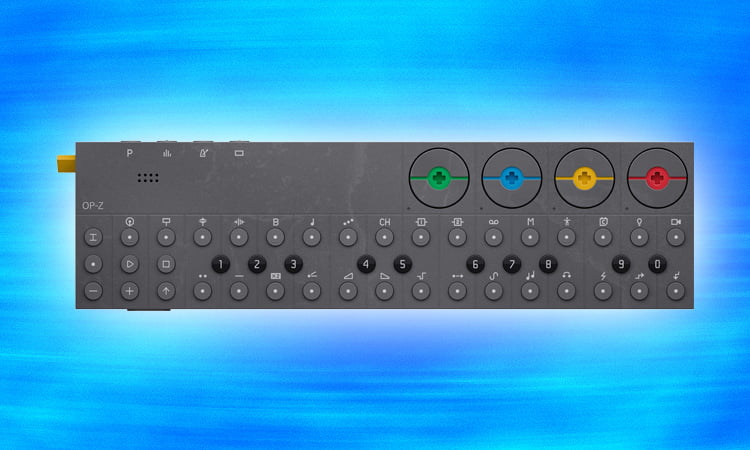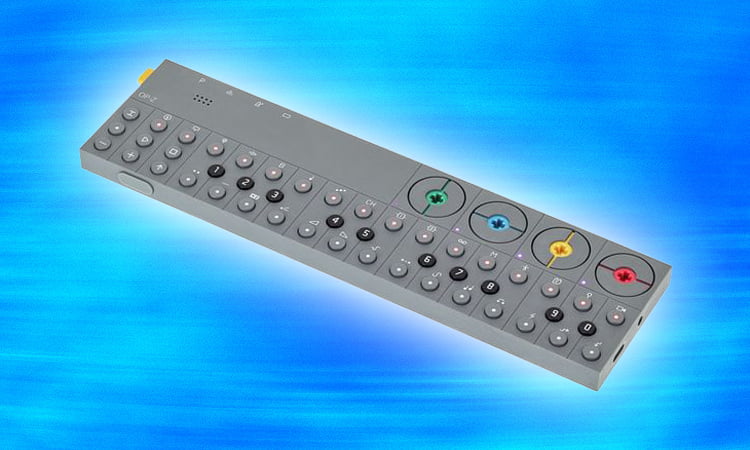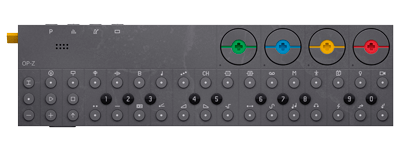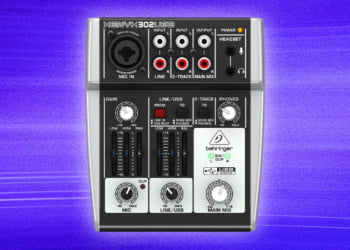Teenage Engineering OP-Z Best Price
In 2010, the young Swedish manufacturer Teenage Engineering caused quite a stir with the compact and unusually equipped synthesizer OP-1, which quickly sold out and was only available again after some time.
I too once succumbed to the digital charm of this inspiring instrument, which I used for several years in the studio and on the road.
At some point, the rumor mill began to bubble in relevant forums as to whether and when a successor to the OP-1 was to be expected and in which features the (presumed) “OP-2” would be upgraded.
In the end, however, not a larger OP-2 was presented, but the co-existing and ultra-compact OP-Z, which has been available in stores since the end of 2018 and looks more like the remote control of a Loewe TV than a serious production tool.
What did the test of the OP-Z, described by the manufacturer as a “multimedia synthesizer and sequencer”, reveal?
No products found.
Concept
The OP-Z shares with the OP-1 the basic concept of a compact and self-sufficient production machine for instrumental songs/beats including sampling functionality.
The latter is also possible with the OP-Z since the recently released update 1.2.5, which brings us to the next commonality, the constant expansion of the range of functions.
In my opinion, the partly self-confident pricing policy of the Swedes is justified by a remarkable product maintenance.
Updates appear in regular cycles, which in many cases bring considerable upgrades.
Thus, one finds various hints on the homepage that further updates with new functions, for example in the form of additional synth engines, will follow.
Despite all the similarities, there are of course differences to the OP-1.
While the OP-1 inspired extensive experimentation with the various synthesis forms, the focus of the OP-Z is clearly on the extensively equipped sequencer, which allows both step programming and real-time recording.
This offers a total of 16 tracks, only half of which are dedicated to instruments (4 drum/4 synth tracks).
The remaining eight tracks allow the automation of audio and various performance effects as well as the sequencing of images (Photomatic) and 3D animations (Motion).
Using a separately available adapter, even DMX-compatible lighting systems can be controlled via sequencer.
Synthesizer enthusiasts who like to program their own sounds have to be content with comparatively rudimentary access options.
Case
The OP-Z, which is suitable for a jacket pocket, measures 212.5 x 10 x 57.5 mm (W/H/D) and is hardly larger than two children’s Countries lined up next to each other.
Nevertheless, it looks serious in its own way, which is due to the – I’ll call it – industrial design and the weight (180 g), which is high relative to the size.
The OP-Z is externally (as internally) not a gadget like the popular and much cheaper models of the Pocket Operator series (PO-35 Speak, PO-33 K.O!, PO-32 Tonic, PO-20 Arcade, PO-24 Office, PO-28 Robot, PO-14 Sub, PO-16 Factory), even though some OP-Z features are taken from the hip pocket synths.
The case is made of a solid-looking fiberglass-plastic mix, though the OP-1, which is currently about twice as expensive, unquestionably has higher-quality casing.
User Interface – Hardware controls
The OP-Z is operated via 51 buttons, 47 of which are equipped with a single- or multi-colored LED, and 24 buttons serve in their dual function as a keyboard for note input/recording.
For entering dynamic mix, sound and other creative parameters, the Swedish multimedia synth has four colored encoders, which are indeed excellent for precise value entry, even if you don’t necessarily see it on them.
Each encoder is assigned a multicolored LED, whereby various status information and parameter assignments are color-coded.

If you have not noticed yet: The OP-Z does not have a display for the visualization of its parameter settings, but informs the user with different colors about the status and value of the device parameters, so that a display is not absolutely necessary for the work.
Nevertheless, a graphical display/user interface is possible and subjectively sensible for working with the OP-Z – more about this in the following paragraph.
The inconspicuous, pressure-sensitive rubber pad mounted on the front left side of the case is a pitch bender, while the conspicuous yellow potentiometer, also mounted on the left, is used for power on/off as well as volume control.
Another button is located on the bottom of the OP-Z and enables Bluetooth pairing with iOS devices.
What’s the point?
OP-Z App
By pairing as just mentioned and using the free OP-Z app, iOS devices can be used as a screen and touchscreen for parameter editing and sequencer programming.
Likewise, the iOS display serves to visualize the graphical gimmicks (Photomatic, Motion) and “documents” the use of Punch-in FX with flashy graphic effects.
Unfortunately, Android users have been left out in the cold so far, but it cannot be ruled out that Teenage Engineering will add an Android app with an upcoming update.
Ports, speaker and mic
The highlight of the current operating system is the OP-Z’s “Audio Interface” functionality. Connecting the OP-Z’s USB-C jack to your DAW allows for digital audio overdubs (real-time) in both directions.
Analog connections come in the form of a single 3.5mm TRRS jack, which is typically used as an audio output for headphones, speakers, or mixers.
When using a headset, its microphone can be used for recording, e.g. vocal samples.
Alternatively, the microphone built into the housing (MEMS) can be used for this purpose.
Furthermore, the OP-Z has a puristic speaker for rudimentary monitoring of the output signal.
Scope of delivery
The scope of delivery of the little Swede is quite spartan.
The OP-Z is delivered in a cardboard box including two leaflets, a Quick Guide as well as a colorful cardboard/paper template, which can be used as a kind of introduction tour when using the device for the first time.
A full manual (in English or Japanese) is available online only.
Of key importance is the included 80 cm cable (USB-C to USB-A), which is used to charge the battery and make digital data/audio connections and MIDI.
Additional accessories (OP-Z Roll-Up Bag, oplab modules) are optionally available and were not available for the test.
Practice
How does the OP-Z sound?
Although the device has a stylistic mutability in principle due to its sample import/sampling functionality, the basic character that is familiar to me from the OP-1 is omnipresent.
The following audio examples were created exclusively with the OP-Z, in many cases making use of the available effects and sequencer-induced alienation.
When presenting different sound categories (e.g. synth bass), other tracks were sometimes used as musical context.

In the final audio example, one hears a multitrack sequence without and with the various punch-in FX that can be recorded in the performance track in a two-bar change.
In summary, absolutely punchy and good-sounding results can be achieved with the little gray box.
Even recording with the built-in microphone is quite usable if you cut the samples accordingly clean. However, the built-in speaker sounds a bit makeshift and quickly distorts, which is not particularly surprising.
The use of external monitors or headphones is thus almost mandatory.
It should be noted, however, that the OP-1’s speaker, which is also quite compact, has a noticeably higher utility value.
Synth Engines vs. Sound Design
Those familiar with the OP-1 may be a bit disappointed. Although (mostly) identical synth engines (Bow, Cluster, Digital, Electric, Saw, Shade, Sample, Uranus) are used, the options for targeted access are noticeably decimated.
In addition to the ADSR envelope, filter and LFO, there are only two Engine-specific parameters.
You can call that sufficient for my sake – with the OP-1 I found this to be much more awesome, including the sometimes drastic effects on the sound design by the internal effects, which are more conservative with the OP-Z with the current operating system.
One may be curious about coming updates.
Sequencer
The 16-track sequencer is definitely the heart and strength of the OP-Z.
Eight instrument tracks (kick, snare, percussion, sampler, bass, lead, arpeggio, chords) are available for step programming or optional real-time recording.
The remaining eight tracks (FX1, FX2, Tape, Master, Performance, Module, Light, Motion) are generally used to control visual sequences as well as the broad package of – I’ll call them – musical performance effects, which can also be heard many times in the audio samples.
The latter is the highlight of the OP-Z. Punch-In FX, Step Components, Parameter Locks as well as pitch/sound variations on the master track and Tape FX are definitely a luxurious toolbox that ensures a varied and contemporary beat production.
The methodical listing of all details can be seen in the manual. In summary and somewhat simplified, however, the functionality of the Step Components, Parameter Locks and Punch-In FX can perhaps be described as follows: Audio effects, musical variations like fills or tonal licks as well as single sound parameters can be controlled by the sequencer (partly also performed live) either per step, track or even group (e.g. drums, synths, master).
I find various step component options very useful here, which in turn vary programmed events on individual steps (random, every xth sequence of the pattern), bringing the pattern to life.
Other core features are the ability to create polyrhythms and pattern chains.
Per Project, 32-link sequences of up to 16 patterns can be arranged, making complex song structures possible.
After various points of criticism in comparison with the OP-1, it must be said at this point that the OP-Z is vastly superior to it in the discipline of sequencing!
As a musician/engineer, the graphic possibilities are of secondary interest to me.
Viewing image sequences, animations and light controls (with optional accessories) might be fun, but if I had the choice, I would definitely prefer additional instrument tracks.
Haptics and workflow
All in all, the OP-Z is blessed with a variety of functions that provide the user with a multitude of possibilities – in a small space, mind you. What one person considers to be the gateway to creativity may only be a crack in the door for another.
Thus, it is controversially discussed in relevant forums and reviews whether it makes more sense to operate the OP-Z with or without the touchscreen of a paired iOS device.
My assessment is that memorizing color codes that define the function of the encoders is a bit confusing and not up to date in my opinion.
The same applies to some cryptic key combinations and the use and linking of step components, which is difficult or impossible to understand without a display.
Thus, I clearly belong to the pro-display faction.
Furthermore, while working with the OP-Z, I wondered why they didn’t design the device a bit larger, which would have allowed for more controls.
For example, simultaneous access to performance and master track, which would require an additional row of buttons, would be a definite fun addition when performing and experimenting.
Haptically, the ultra-compact design is also compromised and not really easy to use, which is not exclusively due to the size of the controls as well as their distance from each other.
The quality and reliability of the buttons on my test unit unfortunately does not match the quality I know from the OP-1.
I had to press a button several times to select the desired function, and isolated double triggers also occurred.
Conclusion
Teenage Engineering’s OP-Z is an exceptional mini-workstation for beats and instrumental song structures, and it’s amazing what a punchy yet tidy sound can be created with this compact device without having to call on additional processors to do so.
Although countless videos on social media, for example, are proof that the OP-Z fires up the creativity of many users, the spark didn’t really want to jump for me personally – the little Swede is perhaps not everyone’s cup of tea.
For users who like to work with the OP-Z based on the touchscreen of the paired iOS device, using iOS apps such as Korg Gadget 2 may be more expedient if you’re looking for a compact and self-sufficient device to produce with.
Even though all relevant functions can be operated via the OP-Z hardware, it is subjectively a bit “overhead” and sometimes confusing – but as has been proven, this is also a matter of taste.
How nice that you don’t have to buy a pig in a poke in this day and age.
Due to the return policy of some dealers, you have enough time to find out whether the OP-Z gives you wings or not.
The programming options for light, graphics and photos are, to my knowledge, a unique selling point for a musical instrument to date.
For musicians who feel attracted by these features, there is no alternative to the little gray cuboid from Sweden.
Features
- Multimedia synthesizer and sequencer
- 4 high-resolution encoders
- 51 keys (24 of which can be played as keyboard)
- 29 RGB+W LEDs, 24 W LEDs
- Synth: 9 sound engines (Bow, Cluster, Digital, Electric, Saw, Shade, Sample, Uranus); Drum: 16 sample packs
- Sampling and sample import (aiff, OP-1 format)
- Audio interface functionality via USB (sampling and DAW overdubbing)
- 48 kHz, 24 bit DAC, 115 dB dynamic range
- 2 parallel usable master effects (Crush, Delay, Dist, Rymd(Reverb))
- 16-track sequencer (step and live recording): 1 kick, 2 snare, 3 percussion, 4 sampler, 5 bass, 6 lead, 7 arpeggio, 8 , chords, 9 FX slot 1, 10 FX slot 2, 11 tape, 12 master, 13 performance, 14 modules, 15 light (DMX), 16 motion (image and 3D animations)
- Step Components, Punch-In FX, Parameter Locks
- 10 Projects à 16 Patterns/Pattern Chaining
- DMX light control via optional interface
- MEMS microphone
- Bluetooth 5.0 LE
- iOS devices via Bluetooth can be used as display and for control (free app)
- USB-C port
- Balanced 3.5mm jack (audio output/headset with microphone)
- additional connections (MIDI/Trigger In+Out, PO Sync Out, 3 (max) CV Out, 1 Gate Out) with optional oplab expansion module
- battery: Li-Ion 740 mAh (exchangeable), up to 6 hours operation / 1 year stand-by
- Dimensions: H: 10 mm W: 212.5 mm D: 57.5 mm
- Weight: 180g
No products found.
Review
Teenage Engineering OP-Z
PROS
- Almost unrivaled concept
- Powerful, tight multitrack sequencer
- Convincing sound/production results integrated sampler
- Ultra-compact
- Overall successful visualization and optional control via iOS app
- Digital dubbing via USB
CONS
- Loudspeakers poor compared to the OP-1
- Partly cryptic operation, frequent double assignment of keys
- OP-Z app exclusively for iOS so far
- Processing not quite on the level of the OP-1
- Rudimentary access to the synth engines
Teenage Engineering OP-Z Best Price
We collect information from many stores for best price available

 Amazon.com
Amazon.com






















